Petrographic Markers for Archaeometric Identification of Montjuïc Sandstone, the Flagship Stone of Barcelona (NE Spain)
Abstract
1. Introduction
2. Montjuïc Sandstone
2.1. Historical Use
2.1.1. Roman Quarry
2.1.2. Medieval and Modern Uses
2.2. Geology and Petrography
3. Materials and Methods
3.1. Studied Materials
3.1.1. Sampled Roman Sculptures and Figurative Reliefs
3.1.2. Sampled Roman Mosaic
3.1.3. Sampled Pottery
3.2. Methods
4. Results
4.1. Identification in Roman Sculptures
4.2. Identification in Roman Figurative Reliefs
4.3. Identification in Roman Mosaic
4.4. Identification in Pottery
5. Discussion and Perspectives
6. Conclusions
- K-feldspar clasts with authigenic overgrowths
- Quartz clasts with authigenic overgrowths
- Fractures filled with chalcedony (mainly of length-fast type)
- Absence of carbonatic clasts
- Absence of early carbonatic cement (except for carbonatic nodules of the upper Morrot unit)
- Some Roman sculptures and architectural elements attributed macroscopically to Montjuïc sandstone do not bear their characteristic provenance markers. We have demonstrated that Montjuïc was not the only source of local sandstones used by the Romans to carve sculptures and architectural elements in Barcino. A reevaluation of all the heritage materials that had been previously assigned to Montjuïc provenance would be recommendable.
- The use of Montjuïc sandstone in Roman tesserae has been reported for the first time. Two different lithotypes from Montjuïc have been identified: The commonly exploited sandstones of Castell unit and carbonate-rich nodules from the underlaying Morrot unit. This constitutes the first evidence of Roman extraction points located at the bottom part of the south-east steep cliff of Montjuïc. Colorimetric analyses are suggested as a non-destructive approach to perform a first screening on other Roman mosaics liable to contain Montjuïc tesserae.
- The use of Montjuïc sandstone as pottery temper has been reported in the productions of a medieval (12–13th century) workshop in Barcelona. A systematic petrographic survey oriented to identify the specific provenance markers would be useful to determine the temporal range of such particular use of the Montjuïc sand and the spatial distribution of the corresponding pottery productions.
Author Contributions
Funding
Acknowledgments
Conflicts of Interest
References
- Tite, M.S. Archaeological science—Past achievements and future prospects. Archaeometry 1991, 33, 139–151. [Google Scholar] [CrossRef]
- Neff, H. Chemical Characterization of Ceramic Pastes in Archaeology (Monographs in World Archaeology); Neff, H., Ed.; Prehistory Press: Madison, WI, USA, 1992. [Google Scholar]
- Hein, A.; Tsolakidou, A.; Iliopoulos, I.; Mommsen, H.; Garrigós, J.; Montana, G.; Kilikoglou, V. Standardisation of elemental analytical techniques applied to provenance studies of archaeological ceramics: An inter laboratory calibration study. Analyst 2002, 127, 542–553. [Google Scholar] [CrossRef] [PubMed]
- Baxter, M.J. Exploratory Multivariate Analysis in Archaeology, Revised ed.; Eliot Werner Publications-Inc.: Clinton Corners, NY, USA, 2015. [Google Scholar]
- Ricca, M.; Paladini, G.; Rovella, N.; Ruffolo, S.A.; Randazzo, L.; Crupi, V.; Fazio, B.; Majolino, D.; Venuti, V.; Galli, G.; et al. Archaeometric characterisation of decorated pottery from the archaeological site of villa dei quintili (Rome, Italy): Preliminary study. Geosciences 2019, 9, 172. [Google Scholar] [CrossRef]
- Reedy, C. Thin-Section Petrography of Stone and Ceramic Cultural Materials; Archetype Publications: London, UK, 2008. [Google Scholar]
- Quinn, P. Interpreting Silent Artefacts: Petrographic Approaches to Archaeological Ceramics; Archaeopress: Oxford, UK, 2009. [Google Scholar]
- Quinn, P. Ceramic Petrography: The Interpretation of Archaeological Pottery & Related Artefacts in Thin Section; Archaeopress: Oxford, UK, 2013. [Google Scholar]
- Re, A.; Angelici, D.; Lo Giudice, A.; Maupas, E.; Giuntini, L.; Calusi, S.; Gelli, N.; Massi, M.; Borghi, A.; Gallo, L.M.; et al. New markers to identify the provenance of lapis lazuli: Trace elements in pyrite by means of micro-PIXE. Appl. Phys. A 2013, 111, 69–74. [Google Scholar] [CrossRef]
- Tsydenova, N.; Morozov, M.V.; Rampilova, M.V.; Vasil’ev, Y.A.; Matveeva, O.P.; Konovalov, P.B. Chemical and spectroscopic study of nephrite artifacts from Transbaikalia, Russia: Geological sources and possible transportation routes. Quat. Int. 2015, 355, 114–125. [Google Scholar] [CrossRef]
- Gallello, G.; Orozco, T.; Pastor, A.; de la Guardia, M.; Bernabeu, J. Regional provenance of dolerite prehistoric objects through mineral analysis. Microchem. J. 2016, 124, 167–174. [Google Scholar] [CrossRef]
- Niknami, K.; Amirkhiz, A.; Glascock, M. Provenance studies of Chalcolithic obsidian artefacts from near Lake Urmia, northwestern Iran using WDXRF analysis. Archaeometry 2009, 52, 19–30. [Google Scholar] [CrossRef]
- Newlander, K.; Lin, Y. Integrating visual and chemical data to source chert artifacts in the North American Great Basin. J. Archaeol. Sci. Rep. 2017, 11, 578–591. [Google Scholar] [CrossRef]
- La Russa, M.F.; Randazzo, L.; Ricca, M.; Rovella, N.; Barca, D.; Ruffolo, S.A.; Berikashvili, D.; Kvakhadze, L. The first archaeometric characterization of obsidian artifacts from the archaeological site of Samshvilde (South Georgia, Caucasus). Archaeol. Anthropol. Sci. 2019, 11, 6725–6736. [Google Scholar] [CrossRef]
- Fichera, G.V.; Belfiore, C.M.; La Russa, M.F.; Ruffolo, S.A.; Barca, D.; Frontoni, R.; Galli, G.; Pezzino, A. Limestone provenance in Roman lime-volcanic ash mortars from the villa dei quintili, Rome. Geoarchaeology 2015, 30, 79–99. [Google Scholar] [CrossRef]
- Barca, D.; Fiorenza, E.; D’Andrea, M.; Le Pera, E.; Musella, M.; Sudano, F.; Taliano Grasso, A. Chemical and petrographic characterization of stone and glass tesserae in the nereid and geometric mosaics from the S. Aloe quarter in vibo valentia–Calabria, Italy. Minerals 2019, 9, 729. [Google Scholar] [CrossRef]
- Randazzo, L.; Ricca, M.; Ruffolo, S.; Aquino, M.; Davidde Petriaggi, B.; Enei, F.; La Russa, M.F. An integrated analytical approach to define the compositional and textural features of mortars used in the underwater archaeological site of castrum novum (Santa Marinella, Rome, Italy). Minerals 2019, 9, 268. [Google Scholar] [CrossRef]
- Herz, N. Provenance determination of Neolithic to Classical Mediterranean marbles isotopes. Archaeometry 1992, 34, 185–194. [Google Scholar] [CrossRef]
- Brilli, M.; Savin, M.-C. Provenance study of the white marbles of the “Baths of Elagabalus” at the Palatine Hill in Rome. Archaeol. Anthropol. Sci. 2019, 11. [Google Scholar] [CrossRef]
- Wielgosz-Rondolino, D.; Antonelli, F.; Bojanowski, M.J.; Gładki, M.; Göncüoğlu, M.C.; Lazzarini, L. Improved methodology for identification of Göktepe white marble and the understanding of its use: A comparison with Carrara marble. J. Archaeol. Sci. 2020, 113, 105059. [Google Scholar] [CrossRef]
- Ricca, M.; Belfiore, C.M.; Ruffolo, S.A.; Barca, D.; De Buergo, M.A.; Crisci, G.M.; La Russa, M.F. Multi-analytical approach applied to the provenance study of marbles used as covering slabs in the archaeological submerged site of Baia (Naples, Italy): The case of the “Villa con ingresso a protiro”. Appl. Surf. Sci. 2015, 357, 1369–1379. [Google Scholar] [CrossRef]
- Miletic, S.; Kramar, S.; Lux, J.; Šmuc, A.; Zupancic, N. Provenance analysis of Roman stone artefacts from sedimentary rocks from the archaeological site near Mošnje, NW Slovenia. Geologija 2016, 59, 35–54. [Google Scholar] [CrossRef]
- Haughton, P.D.W.; Todd, S.P.; Morton, A.C. Sedimentary Provenance Studies; Geological Society of London: London, UK, 1991. [Google Scholar]
- Akarish, A.; Dessandier, D. Characterization and source of sedimentary rocks of the alexandria lighthouse archaeological objects, Egypt. J. Appl. Sci. 2011, 11. [Google Scholar] [CrossRef][Green Version]
- Carbonell, E.; Sala, R.; Cebrià, A. El Taller de Jaspis Del Morrot de Montjuïc. Primers Indicis de Protomineria al Paleoestuari del Llobregat; Ajuntament de Barcelona: Barcelona, Spain, 1997. [Google Scholar]
- Asensio, D.; Cela, X.; Miró, C.; Miró, M.T.; Revilla, E. El nucli ibèric de Montjuïc. Les sitges de Magòria o de Port. Barcelona. Quarhis Quad. d’Arqueologia Història Ciutat Barc. 2009, 5, 15–85. [Google Scholar]
- Granados, O.; Mazaira, L.; Miró, M.T.; Rovira, C.; Salgot, D. Intervencions arqueològiques a la muntanya de Montjuïc 1984–1990. Centre de Documentació MUHBA, Unpublished Excavation Report. 1990. [Google Scholar]
- Blanch, R.M.; Granados, J.O.; Miró, C.; Miró, H.; Revilla, E.; Vilaseca, A. La pedrera romana de Montjuïc. In Proceedings of the III Congrés d’Història de Barcelona: La Ciutat i el seu Territori, Dos Mil Anys d’Història; Institut Municipal d’ Història: Barcelona, Spain, 1993; pp. 129–137. [Google Scholar]
- Miró, C.; Revilla, E. The Roman quarry at Montjuic (Barcelona, Spain). In Interdisciplinary Studies on Ancient Stone. Proceedings of the IX Association for the Study of Marbles and Other Stones in Antiquity (ASMOSIA) Conference; Gutiérrez, A., Lapuente, P., Rodà, I., Eds.; Institut Català d’ Arqueologia Clàssica: Tarragona, Spain, 2012; pp. 680–687. [Google Scholar]
- Garrido, E.A. Arquitectura y Urbanismo de Barcino en Época Alto Imperial: La Decoración Arquitectónica de Edificios Públicos y Privados. Ph.D. Thesis, Universitat Autònoma de Barcelona, Barcelona, Spain, 2011. [Google Scholar]
- Ravotto, A. La Muralla de Barcino. Ph.D. Thesis, Universitat Autònoma de Barcelona, Barcelona, Spain, 2017. [Google Scholar]
- Gutiérrez Behemerid, M.Á. El templo romano de Barcino. Análisis de la decoración arquitectónica. Cuad. Arquit. Rom. 1991, 1, 95–105. [Google Scholar]
- Claveria, M. Los togados y estatuas vestidas de Barcino. Arch. Español Arqueol. 2018, 91, 243–263. [Google Scholar] [CrossRef]
- Moreno, M. Retratos en piedra local de la zona nororiental. In Escultura Romana en Hispania. Actas de la VIII Reunión Internacional de Escultura Romana en Hispania, 5–8 de octubre de 2016; Márquez, C., Ojeda, C., Eds.; UCOPress: Córdoba, Spain, 2018; pp. 279–297. [Google Scholar]
- Garrido, E.A.; Rodà, I. Los monumentos funerarios de Barcino con decoración figurada en relieve. In Proceedings of the Actas de la VII Reunión de Escultura Romana en Hispania, Homenaje al Prof. A. Balil, Santiago de Compostela i Lugo, Spain, 4–6 de juliol de 2011; Acuña, F., Casal, R., González, S., Eds.; Universidade de Santiago de Compostela: Saint James of Compostela, Spain, 2013; pp. 131–147. [Google Scholar]
- Rodà, I. Darreres troballes epigrafiques en pedra de Barcino. Quarhis: Quad. d’Arqueologia Història Ciutat Barc. 2013, 9, 156–163. [Google Scholar]
- Claveria, M.; Rodà, I. Esculturas e inscripciones del entorno funerario de Barcino. In Signa et Tituli: Monuments et Espaces de Représentation en Gaule Méridionale Sous le Regard Croisé de la Sculpture et de L’épigraphie. Colloque International (Aix-en-Provence, 2009); Augusta-Boularo, S., Rosso, E., Eds.; Centre Camille Jullian: Aix-en-Provence, France, 2015; pp. 175–189. [Google Scholar]
- Beltrán de Heredia, J. La “via sepulchralis” de la plaza Vila de Madrid. Un ejemplo del ritual funerario durante el Alto Imperio en la necrópolis occidental de Barcino. Quarhis Quad. d’Arqueologia I Història Ciutat Barc. 2007, 3, 12–63. [Google Scholar]
- Gutiérrez Behemerid, M.Á. Capiteles romanos de la Península Ibérica. Boletín del Semin. Estud. Arte Y Arqueol. 1986, 52, 83–141. [Google Scholar]
- Rodà, I. La escultura del sur de la Narbonense y del norte de Hispania Citerior: Paralelos y contactos. In Actas de la III Reunión Sobre Escultura Romana en Hispania (RERH); León, P., Nogales, T., Eds.; Ministerio de Educación, Cultura y Deporte: Madrid, Spain, 2000; pp. 173–196. [Google Scholar]
- Rodà, I. Los talleres de la ciudad de Barcino (Barcelona). In Les Ateliers de Sculpture Régionaux: Techniques, Styles et Iconographie: Actes du Xe Colloque International Sur L’art Provincial Romain, Arles et Aix-en-Provence, France, 21–23 mai 2007; Gaggadis-Robin, V., Hermary, A., Reddé, M., Sintès, C., Eds.; Centre Camille Jullian: Aix-en-Provence, France; Musée départemental Arles Antique: Arles, France, 2009; pp. 513–529. [Google Scholar]
- Roca, E. Montjuïc, La Muntanya de la Ciutat; Institut d’Estudis Catalans, Secció de Ciencies i Tecnologia: Barcelona, Spain, 2000. [Google Scholar]
- Roca, E. Barcelona, hija de Montjuic. Barc. Metróp. Mediterránea 2003, 61, 38–41. [Google Scholar]
- Masriera, A.; Caminal, A.; Navarro, R.; Planella, V.; Samper, J.L. Les roques del Temple de la Sagrada Família. Un itinerari petrogràfic a través dels seus elements arquitectònics i ornamentals. Treb. Del Mus. Geol. Barc. 2005, 13, 83–113. [Google Scholar]
- Graupera, J. Moles i molers. Ginys dels molins hidràulics medievals del baix Maresme. In Proceedings of the Aigua, Recurs Vital, Social, Cultural I Econòmic Del Maresme. XII Trobada d’Entitats de Recerca Local i Comarcal Del Maresme (Dosrius, 2018); Arxiu Comarcal del Maresme: Ajuntament de Dosrius, Spain, 2019; pp. 73–92. [Google Scholar]
- Giresse, P.; Martzluff, M.; Catafau, A. Les pierres et les matériaux de construction du Palais des rois de Majorque. Les sources géologiques et leur choix. In Un Palais Dans La Ville. Volume 1. Le Palais Des Rois De Majorque À Perpignan; Passarrius, O., Catafau, A., Eds.; Éditions Trabucaire: Canet, France, 2014; pp. 211–247. [Google Scholar]
- Español, F. Las manufacturas arquitectónicas en piedra de Girona durante la Baja Edad Media (siglos XII-XV) y su comercialización. Anu. Estud. Mediev. 2009, 39, 1005–1020. [Google Scholar] [CrossRef]
- Calvet, F.; Parcerisa, D.; Gómez-Gras, D.; Tècnica, S. La terra d’escudelles a la Muntanya de Montjuïc. In Proceedings of the Actes de la VI Trobada d’Història de la Ciència I de la Tècnica (Vic, 2000); Societat Catalana d’Història de la Ciència i de la Tècnica: Barcelona, Spain, 2002; pp. 239–249. [Google Scholar]
- Roca, J.L.; Casas, A. Gravimetría en zona urbana. Mapa gravimétrico de la ciudad de Barcelona. In Proceedings of the Actas de la IV Asamblea Nacional de Geodesia y Geofísica; Comunicaciones: Madrid, Spain, 1983; pp. 151–161. [Google Scholar]
- Parcerisa, D.; Gámez, D.; Gómez-Gras, D.; Usera, J.; Simó, A.; Carrera, J.A. Estratigrafía y petrología del subsuelo precuaternario del sector SW de la depresión de Barcelona (Cadenas Costeras Catalanas, NE de Iberia). Rev. Soc. Geológica España 2008, 21, 93–109. [Google Scholar]
- Gómez-Gras, D.; Parcerisa, D.; Calvet, F. Stratigraphy and petrology of the Miocene Montjuïc delta (Barcelona, Spain). Acta Geol. Hisp. 2001, 36, 115–136. [Google Scholar]
- Parcerisa, D.; Thiry, M.; Gómez-Gras, D.; Calvet, F. Proposition d’un modèle de silicification superficielle des grés néogènes de Montjuïc, Barcelone (Espagne): Paragenèses minérales, environnements géochimiques et circulation des fluides. Bull. Soc. Géologique Fr. 2001, 172, 751–764. [Google Scholar] [CrossRef]
- Dott, R.H. Wacke, graywacke and matrix; what approach to immature sandstone classification? J. Sediment. Res. 1964, 34, 625–632. [Google Scholar]
- Parcerisa, D.; Gómez-Gras, D.; Thiry, M.; Calvet, F. Geometría de las silicificaciones en las areniscas miocenas de la montaña de Montjuïc (Barcelona). Geotemas 2000, 2, 171–174. [Google Scholar]
- Riba i Arderiu, O.; Colombo i Piñol, F. Barcelona: La Ciutat Vella i el Poble Nou: Assaig de Geologia Urbana; IEC and Reial Acadèmia de Ciències i Arts de Barcelona: Barcelona, Spain, 2009. [Google Scholar]
- Cantarero, I.; Parcerisa, D.; Plata, M.A.; Gómez-Gras, D.; Gomez-Rivas, E.; Martín-Martín, J.D.; Travé, A. Fracturing and near-surface diagenesis of a silicified miocene deltaic sequence: The montjuïc hill (Barcelona). Minerales 2020, 10, 135. [Google Scholar] [CrossRef]
- Heaney, P.J.; Veblen, D.R.; Post, J.E. Structural disparities between chalcedony and macrocrystalline quartz. Am. Miner. 1994, 79, 452–460. [Google Scholar]
- Garcia i Llinares, M.G.; Moro García, A.; Tuset Bertrán, T. La Seu episcopal D’ègara Arqueologia D’un Conjunt Cristià Del Segle IV al IX; Institut Català D’arqueologia Clàssica: Tarragona, Spain, 2009. [Google Scholar]
- Dunbabin, K.M.D. Mosaics of the Greek and Roman World; Cambridge University Press: New York, NY, USA, 1999. [Google Scholar]
- Balil, A. Mosaicos circenses de Barcelona y Gerona. Boletín Real Acad. Hist. 1962, 257–399. [Google Scholar]
- Nadal, E.R. Intervenció arqueològica al carrer Carders, 39–41/carrer Montanyans, 1–5. Actium, Arqueologia i Patrimoni, Unpublished Excavation Report. 2007. [Google Scholar]
- Nadal, E.R. El forn de ceràmica del carrer Carders. Un centre productor del segle XIII al suburbium oriental de Barcelona. Quarhis: Quad. d’Arqueologia Història Ciutat Barc. 2012, 2, 132–151. [Google Scholar]
- Vousdoukas, M.I.; Velegrakis, A.F.; Plomaritis, T.A. Beachrock occurrence, characteristics, formation mechanisms and impacts. Earth Sci. Rev. 2007, 85, 23–46. [Google Scholar] [CrossRef]
- Marqués Roca, M.A. Las formaciones cuaternarias del delta del Llobregat. Acta Geol. Hisp. 1975, 1, 21–24. [Google Scholar]
- Gómez-Gras, D. El Permotrías de la cordillera costero catalanafacies y petrología sedimentaria (Parte I). Boletín Geológico Min. 1993, 2, 3–49. [Google Scholar]
- Di Febo, R. La ceràmica de Barcelona entre els segles XIII i XVIII a través de la seva caracterització arqueomètrica. Ph.D. Thesis, Universitat de Barcelona, Barcelona, Spain, 2016. [Google Scholar]
- Beltrán Fortes, J.; Baena del Alcázar, L. Arquitectura Funeraria Romana de la Colonia Salaria (Úbeda, Jaén): Ensayo de Sistematización de Los Monvmenta Funerarios Altoimperiales Del Alto Guadalquivir; Empresa Pública de Gestión de Programas Culturales: Sevilla, Spain, 1996. [Google Scholar]
- Gómez, A.; Guerrero, E.; Clop, X.; Bosch, J.; Molist, M. Estudi de la ceràmica neolítica del jaciment de la caserna de Sant Pau. Quarhis Quad. d’Arqueologia Història Ciutat Barc. 2008, 4, 25–35. [Google Scholar]
- Romero, A.; Rosal, J. La Terrissa a Catalunya; Brau Edicions SL: Figueres, Spain, 2014. [Google Scholar]
- Capelli, C.; Parent, F.; Richarté, C.; Vallauri, L.; Cabella, R. Ceramiche invetriate di importazione in Provenza in epoca basso medievale: Dati archeologici e archeometrici. In Proceedings of the Atti XXXVII Convegno Internazionale della Ceramica, Centro Ligure per la Storia della Ceramica (Albisola, 2005); All’insegna del Giglio: Sesto Fiorentino, Italy, 2006; pp. 189–200. [Google Scholar]
- Schiavon, N.; Soria, V.; Arruda, A.M.; Beltrame, M.; Mirão, J. “Losanga” decorated imitations of italic late republican black gloss tableware from South-Western Iberia: A multi-analytical/microchemical characterization. Microchem. J. 2016, 124, 712–718. [Google Scholar] [CrossRef]
- Di Febo, R.; Casas, L.; Capelli, C.; Cabella, R.; Vallcorba, O. Catalan imitations of the ligurian taches noires ware in barcelona (18–19th century): An example of technical knowledge transfer. Minerals 2018, 8, 183. [Google Scholar] [CrossRef]
- Germinario, C.; Cultrone, G.; Cavassa, L.; De Bonis, A.; Izzo, F.; Langella, A.; Mercurio, M.; Morra, V.; Munzi, P.; Grifa, C. Local production and imitations of Late Roman pottery from a well in the Roman necropolis of Cuma in Naples, Italy. Geoarchaeology 2019, 34, 62–79. [Google Scholar] [CrossRef]

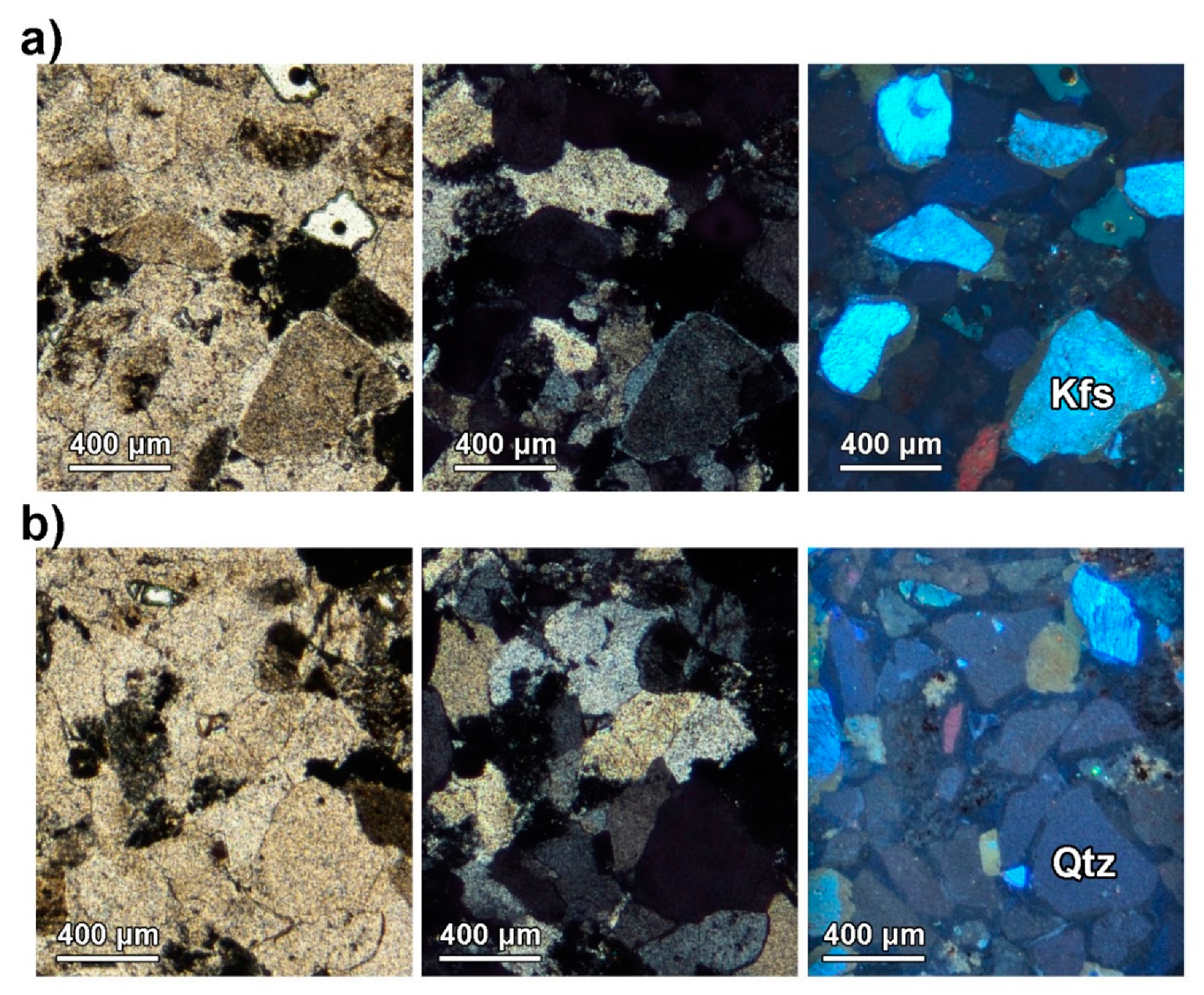
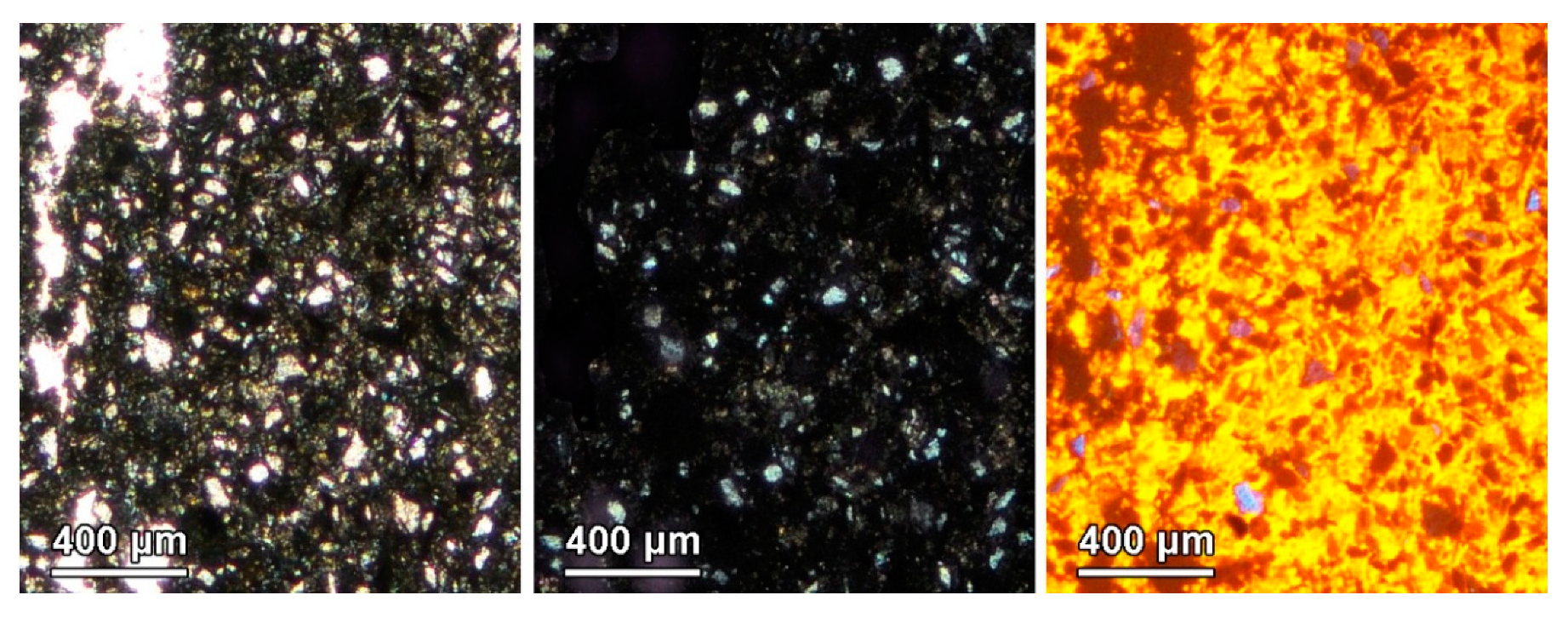
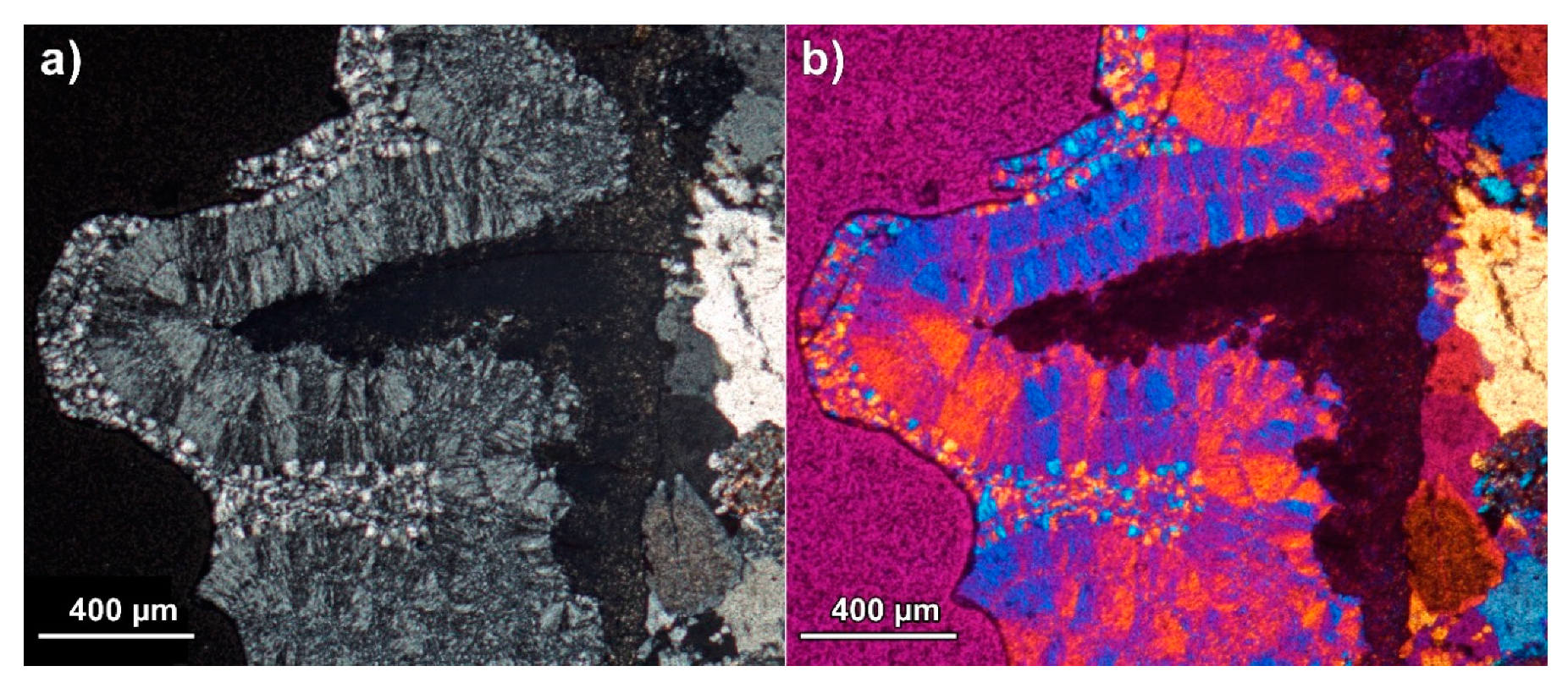
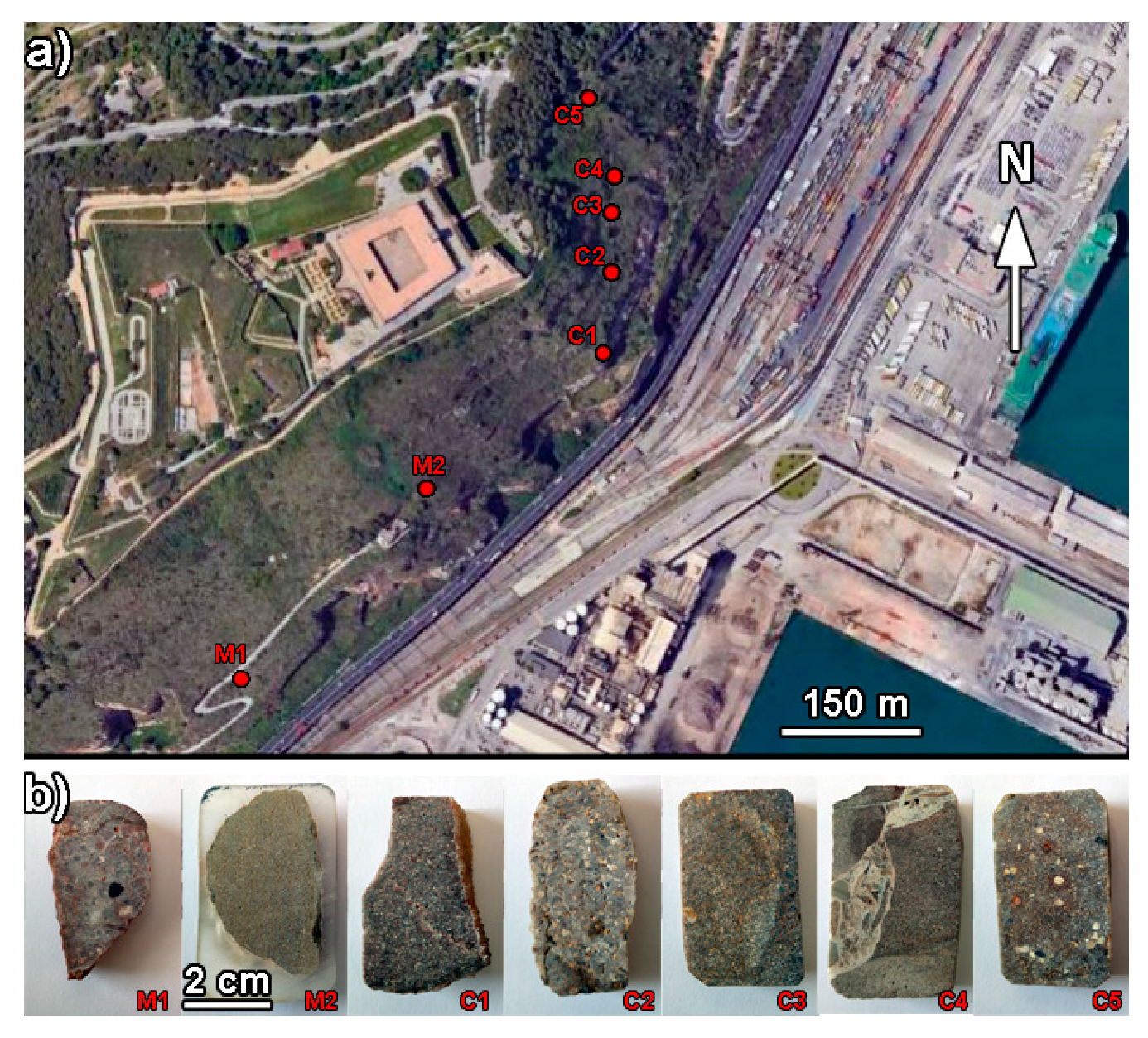

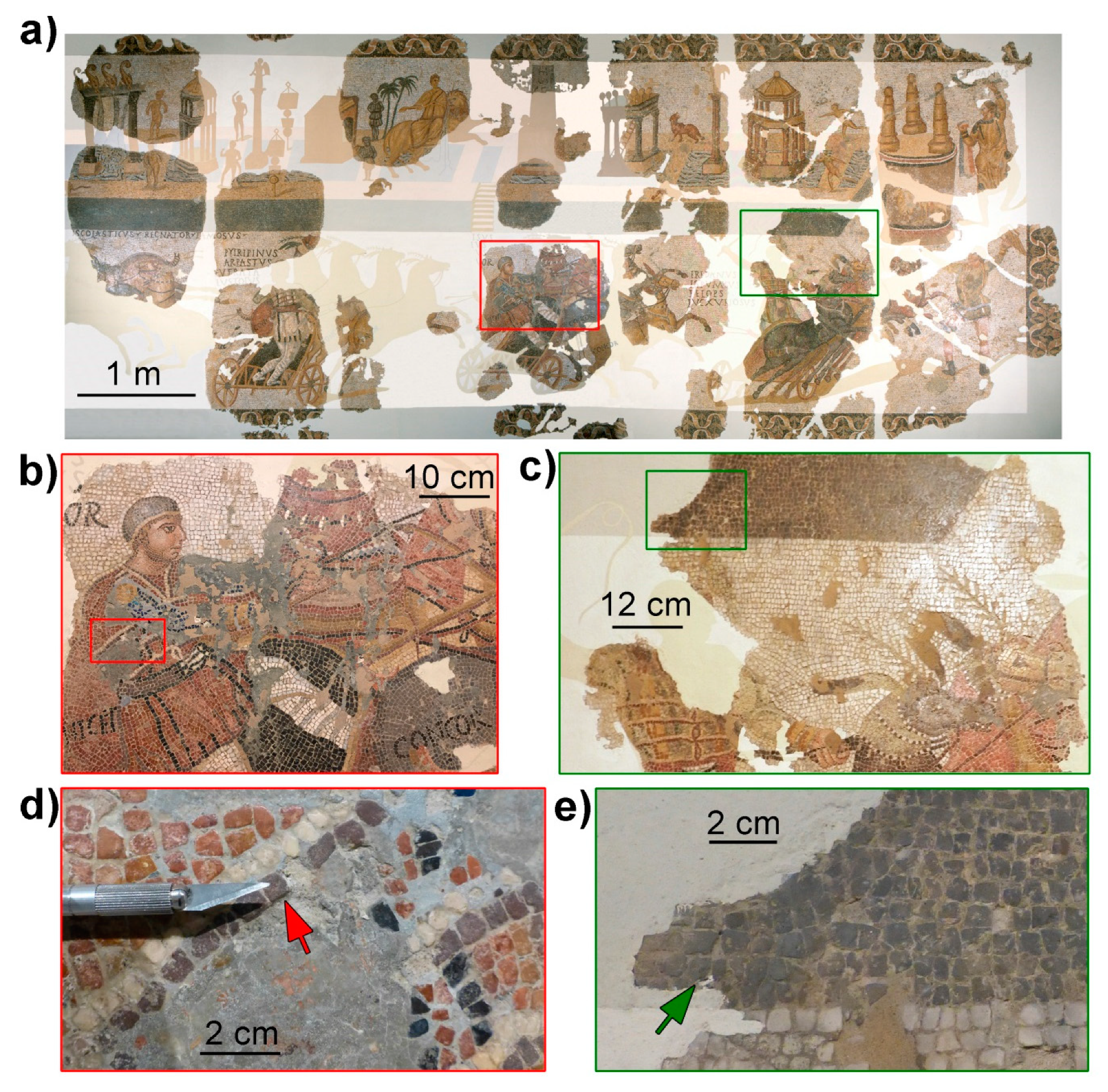
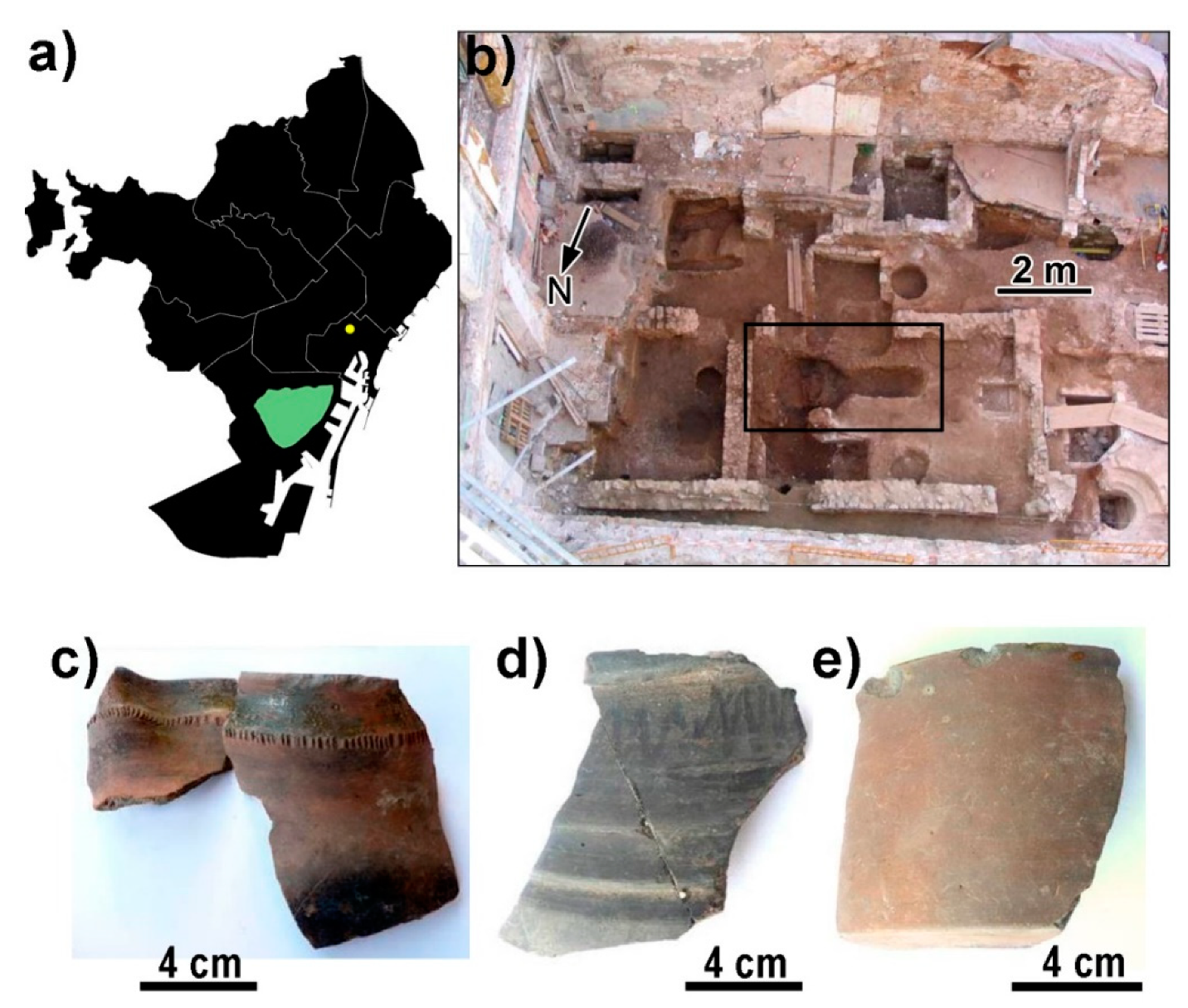
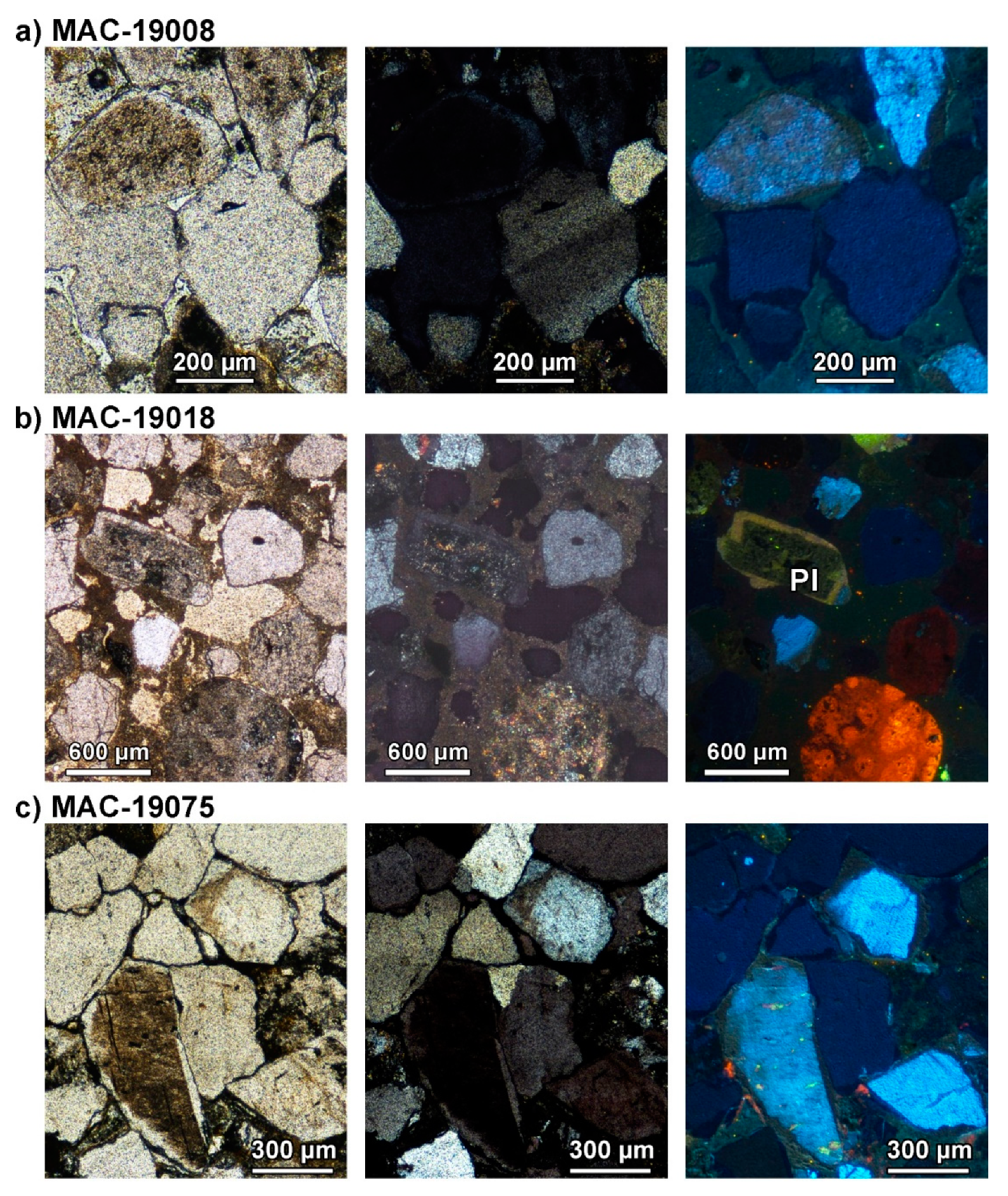
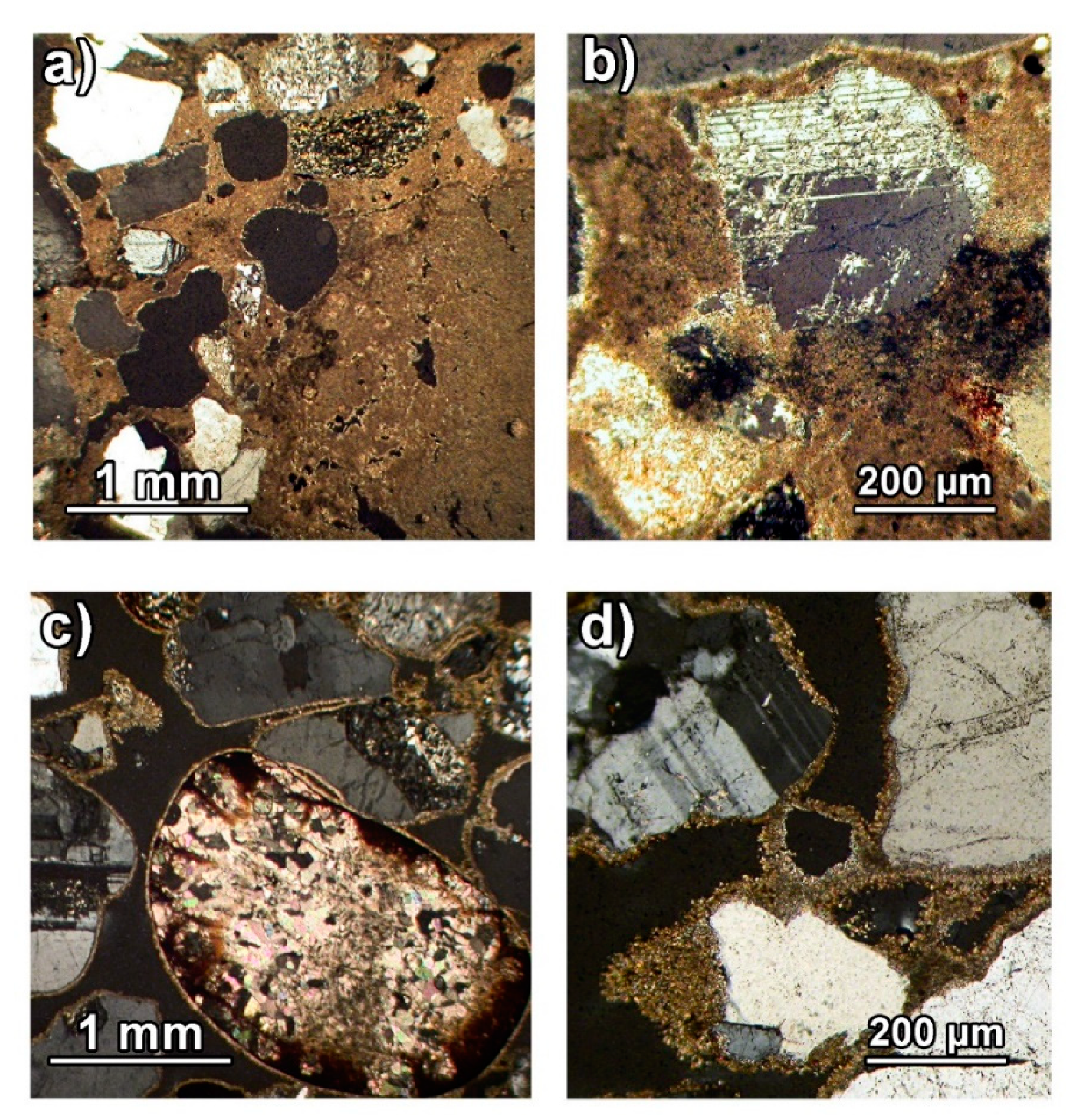
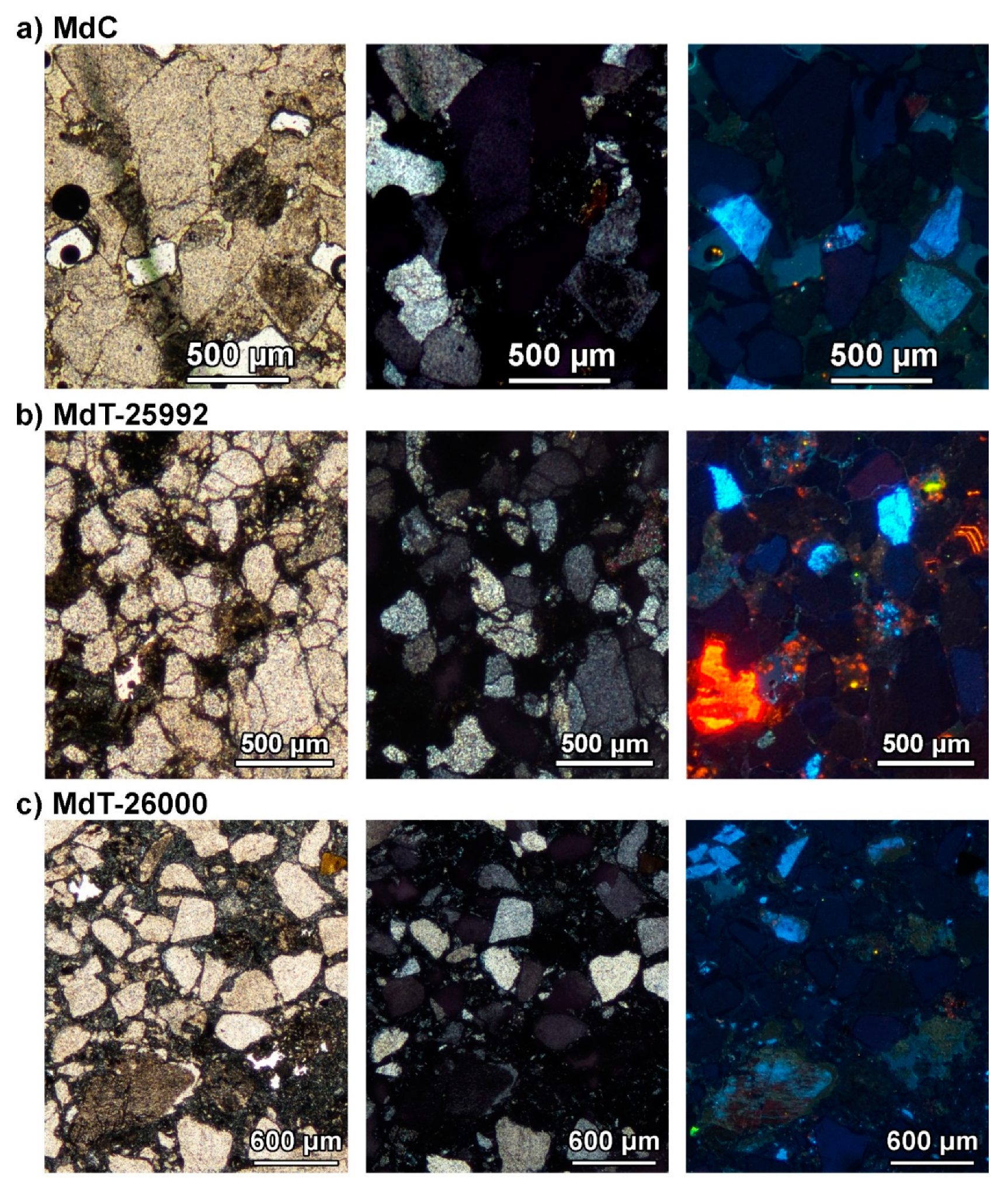
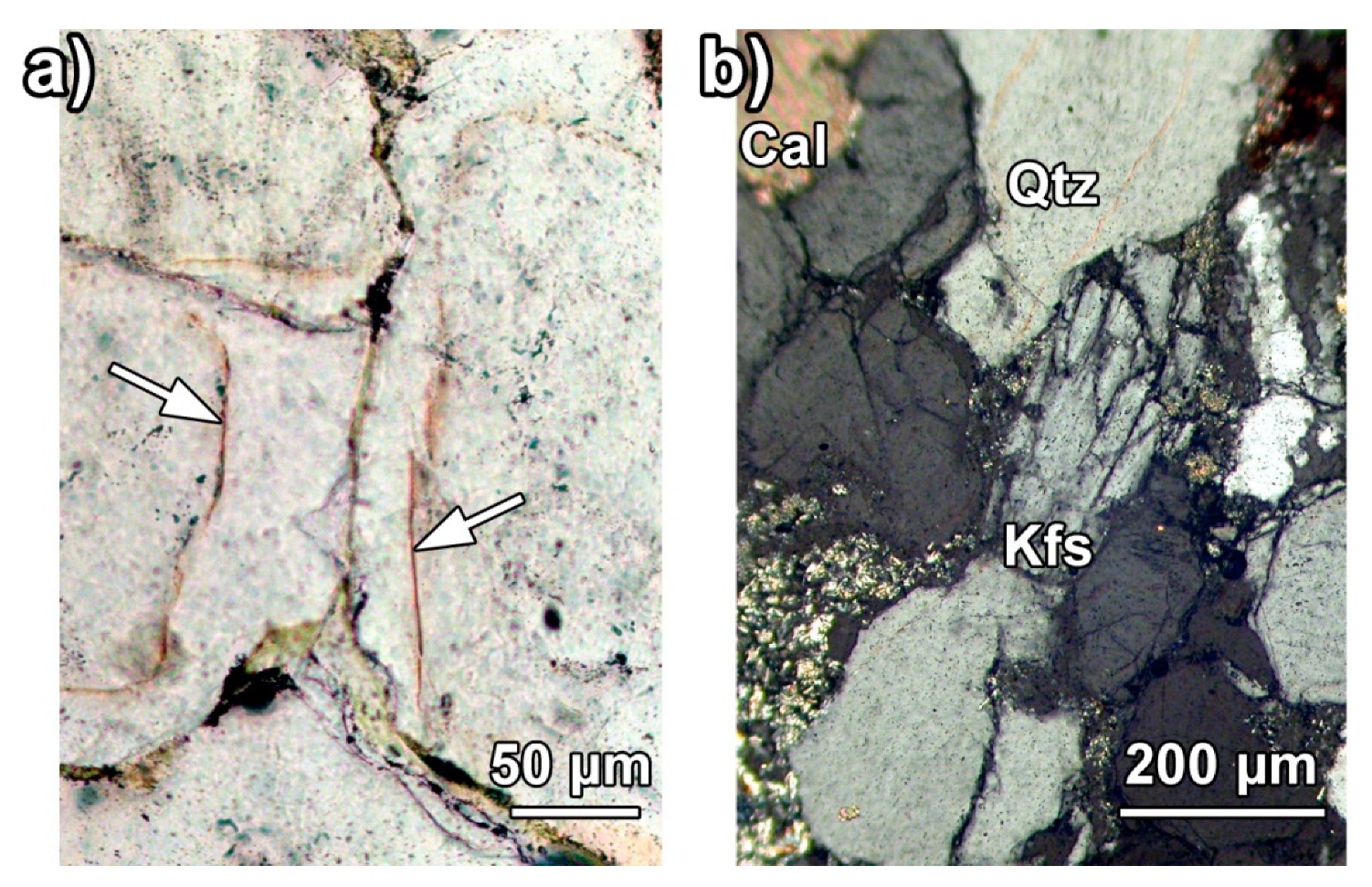

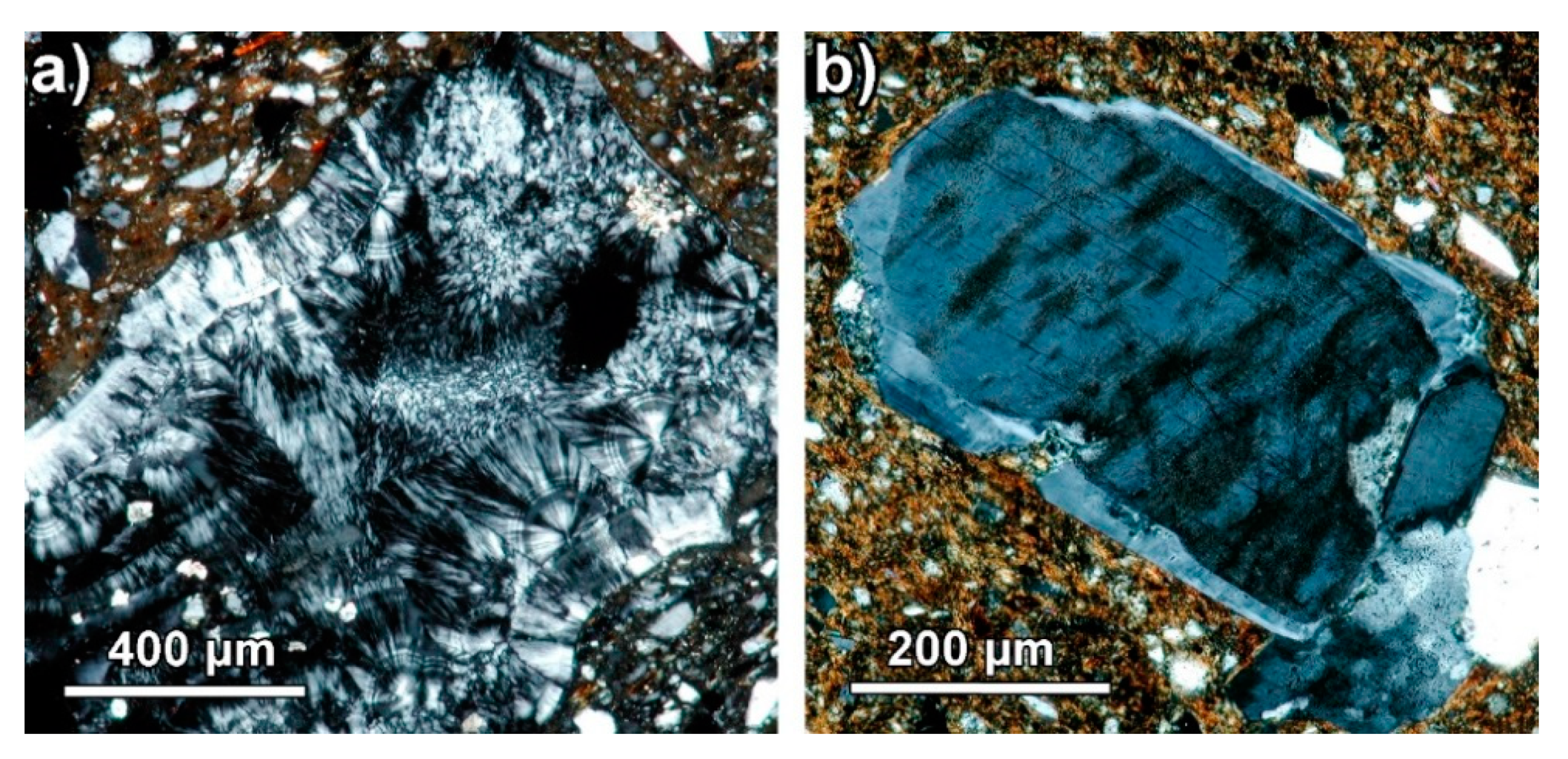
| Heritage Material | Typology | Chronology (Century AD) | Samples | Finding Site | Hosting Museum | ID |
|---|---|---|---|---|---|---|
| Sculptures | Togatus | 1st | 1 | Sant Miquel (Barcelona) | MAC | 19008 |
| Woman with toga | 1st | 1 | Viladecols (Barcelona) | MAC | 19018 | |
| Togatus | 1st | 1 | Sant Miquel (Barcelona) | MAC | 19075 | |
| Figurative reliefs | Stele | 1st | 1 | Bellvitge-Z.Franca (Barcelona) | MdC | - |
| Frieze | 1st | 1 | Seu d’Ègara (Terrassa) | MdT | 25992 | |
| Acroterion | 1st | 1 | Seu d’Ègara (Terrassa) | MdT | 26000 | |
| Mosaics | - | 4th | 2 | Ataülf (Barcelona) | MAC | 19004 |
| Pottery | Oxidized ware | 12–13th | 6 | Carders (Barcelona) | MUHBA | - |
| Reduced ware | 12–13th | 8 | Carders (Barcelona) | MUHBA | - | |
| Glazed reduced ware | 12–13th | 5 | Carders (Barcelona) | MUHBA | - |
© 2020 by the authors. Licensee MDPI, Basel, Switzerland. This article is an open access article distributed under the terms and conditions of the Creative Commons Attribution (CC BY) license (http://creativecommons.org/licenses/by/4.0/).
Share and Cite
Casas, L.; Di Febo, R.; Parcerisa, D. Petrographic Markers for Archaeometric Identification of Montjuïc Sandstone, the Flagship Stone of Barcelona (NE Spain). Minerals 2020, 10, 154. https://doi.org/10.3390/min10020154
Casas L, Di Febo R, Parcerisa D. Petrographic Markers for Archaeometric Identification of Montjuïc Sandstone, the Flagship Stone of Barcelona (NE Spain). Minerals. 2020; 10(2):154. https://doi.org/10.3390/min10020154
Chicago/Turabian StyleCasas, Lluís, Roberta Di Febo, and David Parcerisa. 2020. "Petrographic Markers for Archaeometric Identification of Montjuïc Sandstone, the Flagship Stone of Barcelona (NE Spain)" Minerals 10, no. 2: 154. https://doi.org/10.3390/min10020154
APA StyleCasas, L., Di Febo, R., & Parcerisa, D. (2020). Petrographic Markers for Archaeometric Identification of Montjuïc Sandstone, the Flagship Stone of Barcelona (NE Spain). Minerals, 10(2), 154. https://doi.org/10.3390/min10020154







